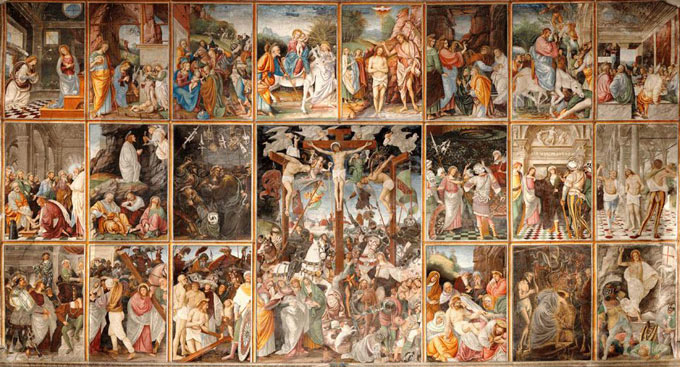The views expressed in our content reflect individual perspectives and do not represent the authoritative views of the Baha'i Faith.
The holy books are full of significance and must never be taken literally…. It is essential to have divine perception in order to see the truth, to hear the call, and obey — liberating the hearts from all earthly attachment. – Abdu’l-Baha, Divine Philosophy, p. 38.
The Christian faith hinges on a belief in the resurrection, or so writes the Apostle Paul (1 Cor 15:14-17), but what does the resurrection mean to Paul?
Most Westerners know the commonly-taught story of the resurrection of Christ: Jesus died; and then, three days later, literally rose from his grave and proceeded to visit certain people to show them that he had conquered death and that they must go forth and tell the world. We now have, however, abundant reason to suspect the truth of this literal version of the resurrection — and to realize that the resurrection actually refers to something far more sublime and meaningful.
The Bible attributes the earliest written accounts of the resurrection to Paul. Before we can look at resurrection accounts, however, we must consider how Paul uses language. Paul’s language is far from simple, being filled with rich imagery and metaphor. In a letter to Timothy (1 Tim 1:1213), Paul spoke as if Jesus personally put him in the ministry and forgave him of the abuse, persecution, and outrage he directed towards Christ and Christians. We know that Paul, however, never met Jesus during His ministry. Paul referred to his being chosen and forgiven as a spiritual event not a physical event. Similarly, when Paul told the Corinthians (2 Cor 13:5) that Jesus Christ was in them, no one thinks that Paul was speaking about the body of Jesus being literally in them. Obviously, he was referring to a spiritual, not physical, reality. Further, when Paul told the Christians from Colossae (3:1) that they were dead, that their lives were now hidden with Christ in God, and that they must set their affections on the next world if they were to be risen with Christ; Paul was not speaking literally. He did not speak to dead men who had been bodily transported to heaven beside Christ. He used symbolic language to paint a portrait of spiritual reality, not physical reality. Biblical scholars know they must proceed with extreme caution if they want to attribute a literal meaning to Paul’s words.
The Pauline reference most commonly cited as proof that Jesus rose physically from the grave comes from his letter to the Corinthians, where he writes (1 Cor 15:38):
For I delivered unto you first of all that which I also received, how that Christ died for our sins according to the scriptures; And that he was buried, and that he rose again the third day according to the scriptures: And that He was seen of Cephas [Peter], then of the twelve:
After that, he was seen of above five hundred brethren at once; of whom the greater part remain unto this present, but some are fallen asleep. After that, He was seen of James; then of all the apostles. And last of all He was seen of me also, as one born out of due time.
But what does Paul mean when he says Christ “was seen,” or as the New International Version translates “appeared”? Can we understand this literally, when we have seen that Paul often uses physical imagery for spiritual (i.e. nonphysical) events? Could Paul understand the resurrection another, more metaphorical or symbolic way?
It helps to know that preaching the resurrection had become a major preoccupation of Paul’s, even before he converted to Christianity. He extolled the idea of the resurrection, a part of his native Phariseeism and a main point of difference between the Pharisees and the Sadducees. He later made use of that fact when he was on trial. (see Acts 23:6-8). Thus for Paul, the resurrection existed well before the crucifixion of Christ. What then did it mean for him?
The Corinthians once asked Paul about the resurrection. This is what he said (1 Cor 15:3540):
But some man will say, How are the dead raised up? and with what body do they come? Thou fool, that which thou sowest is not quickened, except it die: And that which thou sowest, thou sowest not that body that shall be, but bare grain, it may chance of wheat, or of some other grain: But God giveth it a body as it hath pleased Him, and to every seed His own body. All flesh is not the same flesh: but there is one kind of flesh of men, another flesh of beasts, another of fishes, and another of birds. There are also celestial bodies, and bodies terrestrial: but the glory of the celestial is one, and the glory of the terrestrial is another.
He continues to say (v. 44): “It is sown a natural body as an animal body, it is raised as a spiritual body.” With this description in mind, how can we believe some “saw” the resurrection of the physical body of Christ some days after Jesus’ crucifixion?
We may respond with Paul, “how foolish!” The body with which God clothed Jesus at the very moment of his release from his physical body, with all its pain and limitations, was, we may safely assume, far more glorious than his physical body. With this and much more Biblical evidence in mind, we can easily understand that the resurrection Paul preached was a spiritual resurrection.

















Comments
Sign in or create an account
Continue with Googleor